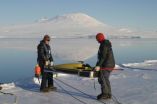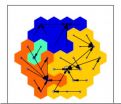How does anesthesia disturb self-perception?
2011-01-20
(Press-News.org) An Inserm research team in Toulouse, led by Dr Stein Silva (Inserm Unit 825 "Brain imaging and neurological handicaps"), working with the "Modelling tissue and nociceptive stress" Host Team (MATN IFR 150), were interested in studying the illusions described by many patients under regional anaesthetic. In their work, to be published in the journal Anesthesiology, the researchers demonstrated that anaesthetising an arm affects brain activity and rapidly impairs body perception.
The ultimate aim of the work is to understand how neuronal circuits are reorganised at this exact moment in time and to take advantage of anaesthesia to reconfigure them correctly following trauma. This would allow anaesthetic techniques to be used in the future to treat pain described by amputated patients in what are known as "phantom limbs".
Neuroscience research in recent years has shown that the brain is a dynamic structure. Phenomena such as learning, memorising or recovery from stroke are made possible by the brain's plastic properties. Brain plasticity does not, however, always have a beneficial effect.
For example, some amputated patients suffering from chronic pain (known as phantom limb pain) feel as though their missing limb were "still there". Such "phantom limb" illusions are related to the appearance in the brain of incorrect representations of the missing body part.
Persons under regional anaesthetic describe these very same false images.
Based on these observations, Inserm's researchers wished to discover whether anaesthesia could, in addition to fulfilling its primary function, induce comparable phenomena in the brain. If this were so, anaesthetics could be used as new therapeutic tools capable of modulating brain activity.
With this in mind, a team headed by Dr Stein Silva monitored 20 patients who were to have one of their arms anaesthetised before surgery. The patients were shown 3D images of the hand, shot from different angles, and their ability to distinguish the right hand from the left was assessed. Results showed how anaesthesia affected the patients' ability to perceive their body correctly.
The researchers observed three phenomena based on these tests:
All the patients described false sensations in their arm (swelling, difference in size and shape, imagined posture).
In general, patients under anaesthetic took longer to distinguish between a left and right hand and made far more mistakes than persons not under anaesthetic.
The best results were obtained when the anaesthetised limb was visible.
In other words, anaesthetising the hand (peripheral deafferentation ) modifies brain activity and rapidly changes the way we perceive the outside world and our own body.
The teams are now using functional brain imaging to characterise the regions concerned in the brain. They also hope that it will be possible to use anaesthesia for therapeutic purposes in the future by modulating post-lesional plasticity (chronic pain in amputated patients, improved recovery in those suffering from brain lesions).
Inserm researcher Stein Silva, an anaesthetist and the chief author of the study, believes that it will no doubt be necessary to develop new anaesthetic techniques to inhibit or directly stimulate the brain images associated with painful phenomena.
INFORMATION:
Source:
Impaired Visual Hand Recognition in Preoperative Patients during Brachial Plexus Anesthesia
Importance of Peripheral Neural Input for Mental Representation of the Hand
Stein Silva, M.D.,* Isabelle Loubinoux, Ph.D.,† Michel Olivier, M.D.,‡ Benoît Bataille, M.D.,‡ Olivier
Fourcade, M.D., Ph.D.,‡ Kamran Samii, M.D., Ph.D.,‡ Marc Jeannerod, M.D., Ph.D.,§ Jean-Francois
Démonet, M.D., Ph.D.
Anesthesiology, January 2011 - http://dx.doi.org/10.1097/ALN.0b013e31820164f1
Contact chercheur:
Stein Silva
Unité Inserm 825 « Imagerie cérébrale et handicaps neurologiques ».
Equipe d'accueil « Modélisation des agressions tissulaires et nociceptives », IFR 150
Université Paul Sabatier.
Email : silva.stein@gmail.com
END
ELSE PRESS RELEASES FROM THIS DATE:
2011-01-20
The blood test procedure used on newborn infants for 40 years is finding a second life in the search for new lifesaving medications, according to an article in the current edition of Chemical & Engineering News (C&EN), ACS' weekly newsmagazine.
C&EN Senior Editor Celia Henry Arnaud notes that collecting drops of blood from patients and depositing the drops on special paper cards to dry has been used for decades to screen newborns for hereditary disorders and infectious disease. But the dried blood spot technology has found a new role at pharmaceutical companies in the ...
2011-01-20
The current Special Issue of Technology & Innovation, Proceedings of the National Academy of Inventors ™, (www.academyofinventors.org), now available on-line at: http://www.cognizantcommunication.com/filecabinet/Technology/techinnovation.html , is focused on the history, process and practice of scientific peer review, with several articles aimed at assessing scientific peer review within the federal government and peer review's relationship to federal policy formation.
According to A. Alan Moghissi, president of the nonproft Institute for Regulatory Science, and Michael ...
2011-01-20
Conservation paleobiologists—scientists who use the fossil record to understand the evolutionary and ecological responses of present-day species to changes in their environment – are putting the dead to work.
A new review of the research in this emerging field provides examples of how the fossil record can help assess environmental impact, predict which species will be most vulnerable to environmental changes and provide guidelines for restoration.
The literature review by conservation paleobiologists Gregory P. Dietl of the Paleontological Research Institution ...
2011-01-20
It is possible to construct a three-dimensional, 3D, face from flat 2D images, according to research published in the International Journal of Biometrics this month. The discovery could be used for biometrics in security applications or in forensic investigations.
Xin Guan and Hanqi Zhuang of Florida Atlantic University on Boca Raton explain how Biometrics, the technology of performing personal identification or authentication via an individual's physical attributes, is becoming an increasingly viable solution for identity management, information protection and homeland ...
2011-01-20
LA JOLLA, CA – A team of scientists at The Scripps Research Institute and the University of Virginia has determined the structure of the protein package that delivers the genetic material of the human immunodeficiency virus (HIV) to human cells.
The work is the culmination of studies carried out over the last decade looking at different portions of the cone-shaped container, or the capsid. The final piece of the puzzle, described in an article published in Nature on January 20, 2011, details the structure of the two ends of the cone.
"This paper is a real milestone ...
2011-01-20
PORTLAND, Ore. – According to research conducted at the Oregon National Primate Research Center at Oregon Health & Science University, the commonly held belief that oral contraceptives cause weight gain appears to be false. The results of the study are published online and will appear in next month's edition of the journal Human Reproduction.
"A simple Google search will reveal that contraceptives and the possibility that they may cause weight gain is a very highly debated topic," said Alison Edelman, M.D., a physician and researcher in the Department of Obstetrics ...
2011-01-20
With mortgage loan defaults on the rise yet again, two mortgage researchers are proposing a new type of mortgage contract that automatically resets the balance and the monthly payment based on the mortgaged home's market value.
Brent Ambrose, Smeal Professor of Real Estate and director of the Institute for Real Estate Studies at the Penn State Smeal College of Business, and Richard Buttimer, a professor in the Belk College of Business at the University of North Carolina at Charlotte, call their new mortgage contract the "adjustable balance mortgage" and contend that it ...
2011-01-20
Researcher Walker Smith of the Virginia Institute of Marine Science, College of William and Mary, has been conducting shipboard studies of biological productivity in Antarctica's Ross Sea for the last three decades. This year he's letting underwater robots do some of the work.
Smith and graduate student Xiao Liu are using a two-year grant from the National Science Foundation to deploy and test a free-swimming underwater glider in the frigid waters of the Ross Sea near the U.S. McMurdo Research Station. The grant also funds efforts by fellow VIMS professor Marjorie Friedrichs ...
2011-01-20
Grand Rapids, Mich. (January 19, 2011) – In a collaborative project involving scientists from three continents, researchers have identified a gene that is mutated in one in three patients with the most common form of renal cancer. The gene – called PBRM1 – was found to be mutated in 88 cases out of 257 clear cell renal cell carcinomas (ccRCC) analysed, making it the most prevalent to be identified in renal cancer in 20 years.
The identification of a frequently mutated gene provides new insights into the biology of the disease, which will be critical in the continued effort ...
2011-01-20
The instability of large, complex societies is a predictable phenomenon, according to a new mathematical model that explores the emergence of early human societies via warfare. Capturing hundreds of years of human history, the model reveals the dynamical nature of societies, which can be difficult to uncover in archaeological data.
The research, led Sergey Gavrilets, associate director for scientific activities at the National Institute for Mathematical and Biological Synthesis and a professor at the University of Tennessee-Knoxville, is published in the first issue of ...
LAST 30 PRESS RELEASES:
[Press-News.org] How does anesthesia disturb self-perception?


